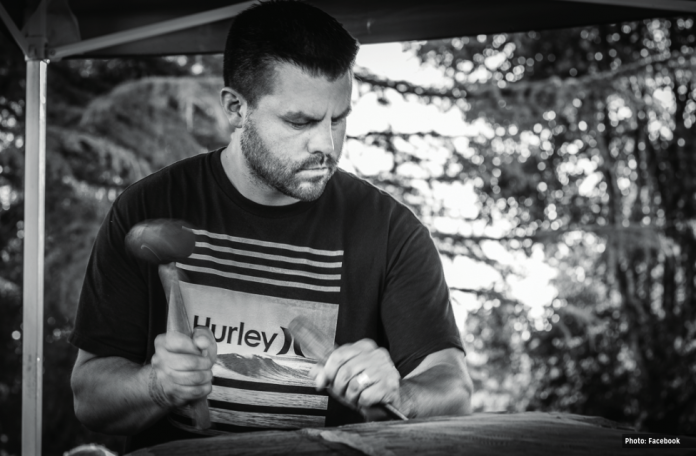On Friday, September 29, the Abbotsford Arts Council held a house post raising ceremony at the Kariton Art Gallery, officially unveiling a recently carved house post, the newest addition to the gallery.
The Kariton’s house post, carved by Raphael Silver, was commissioned by the Abbotsford Arts Council as part of Canada 150 celebrations, and was funded by the Abbotsford Foundation and the City of Abbotsford.
House posts are poles which have been decoratively carved, like totem poles, but are usually found, unlike totem poles, inside structures as opposed to in front of them.
Raphael Silver, the Sumas First Nation artist behind the carving, was present at the Kariton Art Gallery over the summer working on the house post, and is also the recipient of the 2017 Arty Award in the Visual Arts category. This house post is an addition to more publicly accessible artwork by Silver in and around the Fraser Valley, including the carving of salmon currently at the McCallum Road roundabout and Fraser River Heritage Park’s post arch.
Silver, who started painting seriously around the age of 13, had his first paid public art project, a 20-foot mural, commissioned at the age of 15.
“From then, I started picking up the carving just from my dad. I started mimicking my dad carving when I was like eight, when I first got knives.”
Despite the carving of a house post being a practice steeped in tradition, Silver sees himself as a more contemporary artist than a traditional one.
“I don’t really follow the traditional guidelines,” said Silver. “I use traditional structure, but I use a more stylized technique.”
This form of stylized carving, as evidenced by the Kariton’s new house post, takes practical skills, and applies them to the creation of a work of art which is both traditional and contemporary.
“A lot of people don’t see [carving] as a craft,” said Silver. “What I and the people that I emulate create [is a] very contemporary, very stylized art. Certain carvers you would call craftspeople, but there’s another group of carvers that are creating something very unique.”
Apart from his career as an artist, Silver has spent the past couple of months piloting helicopters, aiding firefighting forces trying to curb the nation’s various forest fires.
“Most of my flying was actually done in Alberta. There was a shortage of pilots there because everybody was in B.C., but I was in 100 Mile and 108 Mile at the start of the season,” said Silver. “Once the heavy fires started, I was mostly stuck in Alberta.”
This season’s fires, said Silver, were beyond any he had seen before.
“It was unbelievable. I was grounded in north Alberta, because the smoke there that was coming from B.C. was so bad that we couldn’t see enough to get off the ground.”
Silver recalled seeing 108 Mile at the beginning of the fire season almost in disbelief.
“Seeing it on the second day of the fire was pretty unreal. I drove there through roads that were shut down to everybody, but because I was with the helicopter company, they let me through. The whole place was a ghost town. [There was] smoke and fire on buildings, it was pretty crazy.”
That hair-raising experience, said Silver, lends perspective to his career as an artist.
“That’s where the balance comes in. Flying is both very structured and by-the-seat-of-your-pants. You’re always facing constant unknowns,” he said. “My art career is something that’s generally very relaxing, and I get to be in touch with myself. The art, I have control of.”
Kariton Art Gallery’s house post is now on permanent display, and is accessible to students and community members alike.
With files from Cassie de Jong


